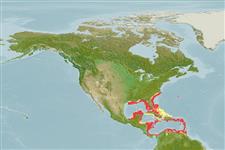Environment: milieu / climate zone / depth range / distribution range
Ecologia
marinhas demersal; intervalo de profundidade 20 - 110 m (Ref. 26268), usually 31 - 110 m (Ref. 26268). Subtropical; 35°N - 2°N, 95°W - 60°W (Ref. 26268)
Western Atlantic: North Carolina and northern Gulf of Mexico in USA to Yucatan.
Tamanho / Peso / Idade
Maturity: Lm ? range ? - ? cm
Max length : 9.0 cm TL macho/indeterminado; (Ref. 7251)
Inhabits bays and shallow coastal waters. Sexual maturity of females attained at 4-4.5 cm (Ref. 26268).
Life cycle and mating behavior
Maturidade | Reprodução | Desova | Ovos | Fecundidade | Larvas
Robins, C.R. and G.C. Ray, 1986. A field guide to Atlantic coast fishes of North America. Houghton Mifflin Company, Boston, U.S.A. 354 p. (Ref. 7251)
Categoria na Lista Vermelha da IUCN (Ref. 130435: Version 2024-1)
Ameaça para o homem
Harmless
Utilização humana
Ferramentas
Relatórios especiais
Descarregue XML
Fontes da internet
Estimates based on models
Preferred temperature (Ref.
123201): 20.7 - 27.5, mean 24.6 °C (based on 144 cells).
Phylogenetic diversity index (Ref.
82804): PD
50 = 0.5000 [Uniqueness, from 0.5 = low to 2.0 = high].
Bayesian length-weight: a=0.01072 (0.00507 - 0.02267), b=3.11 (2.92 - 3.30), in cm total length, based on LWR estimates for this (Sub)family-body shape (Ref.
93245).
Nível Trófico (Ref.
69278): 3.2 ±0.4 se; based on size and trophs of closest relatives
Resiliência (Ref.
120179): Elevada, tempo mínimo de duplicação da população menor que 15 meses (Preliminary K or Fecundity.).
Fishing Vulnerability (Ref.
59153): Low vulnerability (10 of 100).
